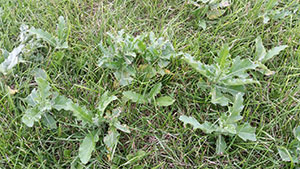 Dandelion, clover, plantain, thistle and other broadleaf weeds are among the most common and troublesome pest problems in lawns. Even though most broadleaf weeds can be easily controlled with herbicides, a completely weed-free lawn is neither practical nor environmentally sensible. A safe and sound approach to lawn weed control is to grow healthy turf, spot-treat weeds with the correct weed control product as they appear, and avoid the temptation to guarantee (or attempt to achieve) 100% weed-free turf.
Dandelion, clover, plantain, thistle and other broadleaf weeds are among the most common and troublesome pest problems in lawns. Even though most broadleaf weeds can be easily controlled with herbicides, a completely weed-free lawn is neither practical nor environmentally sensible. A safe and sound approach to lawn weed control is to grow healthy turf, spot-treat weeds with the correct weed control product as they appear, and avoid the temptation to guarantee (or attempt to achieve) 100% weed-free turf.
The best way to minimize weed problems in lawns is through the use of good cultural practices: proper mowing height and frequency, sensible fertilization, and adequate irrigation. Lawn weeds are encouraged by: mowing too short or not often enough; fertilizing too much, not enough, or at the wrong time of the year; and over- or under-watering.
If chemical control is necessary, the best time to apply herbicides for the control of perennial broadleaf weeds is early-September to early November. Applications in late spring or early summer period after the weeds have flowered are also highly effective. If applying in the late spring, be extremely cautious with these herbicides near ornamental plants, trees, flowers, and vegetable gardens. These plants can be damaged by herbicides through accidental direct application, through drifting through the air, or through volatilization (where the herbicide turns into a vapor).
The number of turfgrass herbicides is too numerous to mention here. It should be noted that combination (2 to 4 herbicides) products provide broader spectrum control of weeds than single herbicides.



